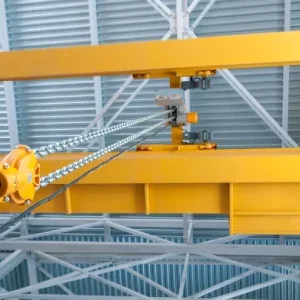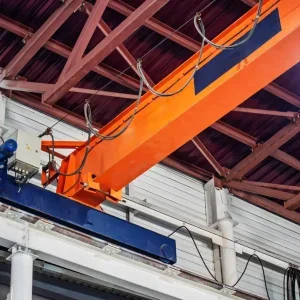Where space is limited, RTGs come into their own, handling up to eight rows of containers. Only if the ship-to-shore crane is a long way from the container storage area might there be good reason to prefer using reach stackers or straddle carriers because they can travel much faster than the 3km/hour that is typical of an RTG.

Port industry statistics show that 2006 was a record year for RTG deliveries, up by more than 40% to more than 900 units, including China. While 2007 was back down towards 2005 levels, global demand remains significantly higher – thanks to the growth in world trade – than what was considered normal in the 1990s.
Konecranes, for example, has received orders this year for RTGs from Spanish company MSC Terminal Valencia (12 units), Terminal de Contenidors de Barcelona, S.L. (seven units), SSA Mexico (six units), and the Russian cargo terminal OJSC Petrolesport in St. Petersburg (four units). The latter order follows previous ones from Petrolesport for a total of 11.

Kalmar, which claims to be the world leader in RTGs outside of China, is also busy, currently fulfilling orders that include one from Transnet in South Africa for 22 E-One+ RTGs for the country’s newest port development, Port of Ngqura, on the Eastern Cape.
Kalmar launched the E-One+ last year as an upgrade on the the E-One that was introduced in 2005. Improvements have been designed to improve quality, ease of maintenance and assembly on site. Key components have been repositioned to make them more easily accessible for maintenance. For example, the emergency hoist stop sensor and spreader cable connection box have been moved to the level of the trolley platform. Another maintenance saving is that the propeller shafts no longer require greasing. And to speed rope maintenance, a small winch can be fitted to the trolley to lift the ropes from ground to trolley level when they need to be serviced or replaced.
Kalmar has also taken orders this year from Somaport at Morocco’s Port of Casablanca (10 units), Abra Terminales Maritimas at the Port of Bilbao in Spain (two units) and Port Nou in Barcelona (two units).

The Port Nou RTGs will have a 16-wheel design to reduce ground load pressure over the traditional eight-wheel design and minimise wear and tear on the terminal surface.
Fuel consumption was also a concern of Port Nou, and so it specified Variable Speed Generators (VSG) to reduce both energy consumption and pollution. Kalmar’s VSG systems optimise engine use by determining whether the crane needs increased power for heavy lifts or little power when idling.
Konecranes’ new generation of RTGs are also designed for fuel efficiency, with a claimed 30% reduction in consumption over previous models.
There is also growing demand for zero-emission electric powered machines. Raimo Ukkonen, Kalmar’s vice president in charge of the RTG product line, says that Kalmar was the first to produce such an RTG, five years ago for the Port of Oslo in Norway. The port wanted to eliminate engine emissions because it is close to a residential area. Four cable electric RTGs were supplied, with sound insulated AC motors in all drives, Bromma spreaders, and an Impact Noise Reduction System (INRS).
Other ports are also starting to consider electric powered RTGs. In June it was announced that Hong Kong International Terminals was embarking on a programme that would see 81 diesel cranes converted to electric power by 2010.
Industrial applications
Raimo Ukkonen says that in his experience global demand for RTGs is 80% from dockside ports and 20% from intermodal rail terminals, moving container boxes between rail cars and trucks. He says that he sees no demand for RTGs from industrial users for general material handling. “In my experience, industrial applications use rail mounted gantry cranes,” he says.

However, this European perspective of the world market differs starkly from the experience of Mi-Jack, a leading US manufacturer of RTGs, based in Hazel Crest, Illinois. In the USA, it seems, RTGs are considered much more versatile than mere box shifters. Mi-Jack vice president Dan Heraty says that in the USA sales of RTGs to industrial applications and rail terminals outnumber port sales by a factor of four to one, roughly speaking. Mi-Jack sells to industrial customers through its Travelift division and is called on to satisfy a wide range of material handling applications.
After all, an RTG is not much other than a regular overhead travelling crane mounted on rubber tyres. Therefore anything an EOT can perform, an RTG may be an equal and often superior alternative.
“An RTG is an overhead crane that can operate throughout your facility,” Heraty explains, “inside and out, and it can go from aisle to aisle.” Like an EOT, but unlike a boom crane, an RTG has no load charts to worry about. It can pick its full capacity, to full height, and carry the load to wherever it can access.

In the USA a significant benefit of an RTG over an installed overhead crane is the tax implications. An EOT crane adds value to a building and therefore increases its tax liability, whereas an RTG is considered mobile equipment, bringing no added value to the fixed asset base and so bringing no addition to the tax burden.
For many years, Mi-Jack’s Travelift division has found a solid customer base for its RTGs in the pre-stressed concrete fabrication industry and among steel fabricators. Other customers including Caterpillar, which uses it to move around the heavy machinery it produces and load them out for delivery.
Newer markets have emerged too, such as the wind power manufacturing sector. Tower sections and blades are long awkward loads that an RTG can handle with relative ease. Mi-Jack’s Travelift RTGs have also moved from beyond construction materials to actual construction itself. The steel and concrete suppliers, familiar with the benefits of the equipment, now use them on projects such as bridge construction, to lay deck sections. Heraty also describes how they are used for bridge widening projects, where the gap between two parallel decks is filled in by laying beams between them and new deck sections on top. The four-legged RTG is driven with two legs on each of the existing carriageways, spanning the gap to be filled.
Mi-Jack offers equipment for hire as well as sale, and construction projects provide a ready rental market. “We have been very successful in renting RTGs for short term periods to erect bridges,” he says.
RTGs used in ports are typically 6+1 containers wide, which is 70ft, and 4+1 containers high. That size, and the specification, is often far more than an industrial application might require. Transverse steering, allowing the machine to travel sideways, is “almost standard in ports”, Heraty says, “but in most industrial applications people don’t need that – it’s an expensive option”. RTGs are very manoeuvrable anyway, even without transverse steering, he says. “They have 90 degree rear wheel pivot steer, so they can turn within their own radius,” he says.
Heraty explains that there are three critical dimensions required when specifying an RTG. These are:
– inside clear width
– hook height
– wheel base dimensions
Inside clear width, which is analogous to span, is in Mi-Jack’s experience usually specified at 40ft (12m) or 60ft (18m).
The required hook height depends on the size of the load that is being handled. “Hook heights are certainly getting bigger every day,” he says.
The rule of thumb for the wheel base, he says, is that it should be a third the length of the longest product at capacity. So if the RTG is to be used to handled 120ft long steel beam, the wheel base should ideally be 40ft to maximise manoeuvrability without compromising stability.
In container handling applications, cylinders and chains can be used to hold the loads since they are all the same height. Elsewhere, hoists and cable give more flexibility in lifting heights, Heraty says.
In standard version, Mi-Jack’s Travelift driver’s cab is sited in front of a rear leg, facing direction of travel. It offers the option of an inward facing cab with a chair that can swivel to face forward as well. It calls this its “barber’s chair cab”. Remote control is also an option.
Mi-Jack Travelift product range has nine models, from the MJ 20 rated at 33,000lbs capacity (15t) up to the MJ 150 rated at 300,000 lbs (136t). However, as the required inside clear width, hook height and wheel base all depend on the customer’s specification, Mi-Jack effectively custom-builds each of these machines. It has a unit that it rents out for bridge widening applications which has an inside clear width of 86ft, enabling it to span gaps between carriageways.
For Mi-Jack the benefit of targeting industrial applications and intermodal rail terminals as well as ports is that it helps to maintain more consistency in the order book. “Ports run hot and cold. Imports in the US are down right now,” Heraty says. Besides, a manufacturer that focuses only on ports, as several overseas competitors seem to, is missing out on the major part of the market. Heraty estimates that in a typical year, if there ever were such a thing, between 20 and 30 RTGs would go into US ports, compared to about 100 going to industrial applications and rail terminals.






